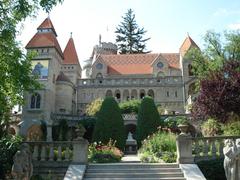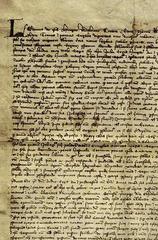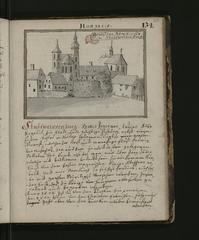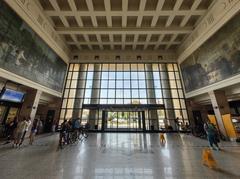Kula-torony Visiting Hours and Tips - Székesfehérvár Historical Sites
Date: 20/07/2024
Introduction
Discover the rich history and architectural marvel of Kula-torony, also known as the Turkish Tower, in Székesfehérvár, Hungary. This iconic monument stands as a testament to the city’s medieval and Ottoman past, offering visitors a unique glimpse into a period marked by cultural and military significance. Built during the Ottoman occupation in the 16th century, Kula-torony served as a critical defensive structure and has since become a symbol of resilience and historical continuity (Székesfehérvár Official Site). Whether you’re a history enthusiast or a casual traveler, this guide provides comprehensive information on Kula-torony, including its origins, architectural significance, and practical visitor information such as visiting hours, ticket prices, and travel tips.
Table of Contents
- Introduction
- Origins and Early History
- Architectural Significance
- Role During the Ottoman Period
- Post-Ottoman Era
- Restoration and Preservation
- Modern-Day Significance
- Visitor Experience
- Travel Tips and Nearby Attractions
- Cultural Impact
- Educational Value
- Future Prospects
- FAQ
- Conclusion
Origins and Early History
Kula-torony’s origins date back to the Ottoman occupation of Hungary in the 16th century. Székesfehérvár fell under Ottoman control in 1543, during which various military and administrative buildings, including Kula-torony, were constructed to consolidate their power in the region (Hungary Tourism).
Architectural Significance
The Kula-torony is a prime example of Ottoman military architecture. Built primarily for defensive purposes, its cylindrical structure, thick walls, and strategic location allowed for monitoring enemy movements and protecting the city from potential invasions. The architectural style of Kula-torony reflects typical Ottoman design, characterized by robust construction and minimalistic aesthetics.
Role During the Ottoman Period
During the Ottoman period, Kula-torony played a crucial role in the military and administrative framework of Székesfehérvár. It was part of a larger network of fortifications and served both as a lookout point and housing for soldiers, ensuring the security of the city.
Post-Ottoman Era
The Ottoman occupation of Hungary ended in the late 17th century. Székesfehérvár was liberated from Ottoman rule in 1688. After the Ottomans departed, many of their architectural contributions, including Kula-torony, were repurposed or fell into disrepair. However, the tower remained a prominent landmark, symbolizing the city’s historical legacy.
Restoration and Preservation
In the 19th and 20th centuries, efforts were made to restore and preserve Kula-torony. Local authorities and heritage organizations undertook various restoration projects to maintain the tower’s structural integrity and historical authenticity. These efforts have ensured that Kula-torony remains a testament to Székesfehérvár’s rich and diverse history.
Modern-Day Significance
Today, Kula-torony stands as a significant historical monument and a popular tourist attraction in Székesfehérvár. The tower offers visitors a glimpse into the city’s Ottoman past and serves as a reminder of the architectural and cultural influences that have shaped the region. The preservation of Kula-torony allows for educational opportunities, enabling visitors to learn about the historical context and significance of the Ottoman period in Hungary.
Visitor Experience
Visiting Hours
Kula-torony is open to visitors from 9 AM to 5 PM daily.
Ticket Prices
Tickets can be purchased on-site for HUF 1,000 for adults and HUF 500 for children and students.
Guided Tours
Guided tours are available daily at 11 AM and 2 PM. Group tours can be arranged by appointment.
Accessibility
The tower is partially accessible to visitors with mobility issues; please contact the site in advance for specific accommodations.
Travel Tips and Nearby Attractions
How to Get There
Székesfehérvár is easily accessible by train or bus from Budapest. The Kula-torony is within walking distance of the city center.
Nearby Attractions
- Bory Castle - A unique architectural marvel built by sculptor and architect Jenő Bory. More information can be found on the Bory Castle website.
- St. Stephen’s Basilica - This historic church is one of the most significant religious sites in Hungary. Visit the basilica’s website for more details.
- King Stephen Museum - Offers a comprehensive look at the history of Székesfehérvár and the surrounding region. More information is available on the museum’s website.
Local Cuisine
Explore nearby restaurants and cafes that offer traditional Hungarian cuisine. Dishes like goulash, chimney cake, and local wines are highly recommended (Hungarian Cuisine).
Cultural Impact
Kula-torony is not only a historical monument but also a cultural symbol. It represents the complex history of Székesfehérvár, reflecting the city’s resilience and adaptability through various periods of occupation and change. The tower’s preservation and continued relevance highlight the importance of cultural heritage in fostering a sense of identity and continuity within the community.
Educational Value
Kula-torony serves as an educational resource, offering valuable insights into the Ottoman period in Hungary. Schools and educational institutions often organize field trips to Kula-torony, providing students with a tangible connection to their history and heritage. The tower’s historical context is also explored in academic research, contributing to a deeper understanding of the region’s past.
Future Prospects
Future plans aim to enhance the visitor experience at Kula-torony. Proposed developments include interactive displays and multimedia exhibits for a more immersive understanding of the tower’s history. Additionally, discussions are underway to create a dedicated visitor center with educational resources and amenities. These initiatives aim to ensure that Kula-torony remains a significant and engaging destination for future generations (Future Developments).
FAQ
- What are the visiting hours for Kula-torony? The tower is open daily from 9 AM to 5 PM.
- How much are the tickets? Tickets cost HUF 1,000 for adults and HUF 500 for children and students.
- Are guided tours available? Yes, guided tours are available daily at 11 AM and 2 PM. Group tours can be arranged by appointment.
- Is the tower accessible to visitors with disabilities? The tower is partially accessible; please contact the site for specific accommodations.
Conclusion
Kula-torony remains a significant historical and cultural landmark in Székesfehérvár, encapsulating the city’s rich past and its resilience through various periods of change. From its origins during the Ottoman occupation to its modern-day status as a popular tourist attraction, the tower offers invaluable insights into Hungary’s diverse heritage. Efforts to preserve and restore Kula-torony ensure that future generations can continue to explore and learn from this remarkable monument. Whether you are interested in its architectural features, historical significance, or simply looking to enjoy the panoramic views of Székesfehérvár, a visit to Kula-torony promises an enriching experience (Hungarian Heritage). For more information and travel tips, visit the Székesfehérvár tourism website.
References
- Explore the Rich History and Visiting Hours of Kula-torony in Székesfehérvár, 2024, Székesfehérvár Official Site
- Visiting Kula-torony - Historical Significance, Tickets, and Travel Tips in Székesfehérvár, 2024, Hungarian Heritage
- Essential Tips for Visiting Kula-torony in Székesfehérvár - Hours, Tickets, and More, 2024, Székesfehérvár Official Site





